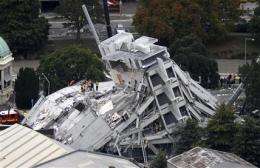Weaker New Zealand quake packed a deadlier punch

(AP) -- The latest New Zealand earthquake is much weaker than the one that rocked the area last September yet caused much more destruction.
Why? Scientists say it's all about location, location, location.
Tuesday's magnitude-6.3 quake was centered about 3 miles from the populated hub of Christchurch, toppling buildings and killing dozens.
The location, the timing during the middle of a workday and the quake's shallow depth of 3 miles combined to make a deadly mix.
The jolt "is squarely beneath the city itself," said seismologist Egill Hauksson of the California Institute of Technology. "All the old historic buildings are being shaken more violently than they were built to withstand."
Scientists classified it as an aftershock of the powerful magnitude-7 that struck last Sept. 4.
No one died in that early morning quake - which was 11 times stronger - mainly because it was centered farther away, about 30 miles west of the city center. It was also twice as deep as Tuesday's aftershock. Shallower quakes tend to be more damaging.
While New Zealand has strict building codes, Christchurch has a number of pre-World War II buildings that were badly damaged by the September quake, which also triggered landslides in the area.
Another reason why this latest quake was more deadly is because buildings that were previously weakened by ground shaking were more likely to suffer damage or even collapse this time around, said Tom Jordan, who heads the Southern California Earthquake Center.
Many cities on the U.S. West Coast face similar seismic risks, experts say.
The West Coast has similar soil as New Zealand, which can turn to mush during an earthquake and worsen damage done by shaking, said Robert Yeats, professor emeritus of geology at Oregon State University.
"New Zealand has some of the most progressive building codes in the world. They are better prepared for an earthquake like this than many U.S. cities would be," Yeats said in a statement.
Since September, about half a dozen aftershocks greater than magnitude-5 have rattled Christchurch. Tuesday's was the largest aftershock to date.
"You can have an aftershock months after the main shock," said geophysicist Paul Earle of the U.S. Geological Survey in Golden, Colo. "Just because a few months have gone by doesn't mean you can't have a large, damaging earthquake."
More information: U.S. Geological Survey: http://earthquake.usgs.gov/
©2010 The Associated Press. All rights reserved. This material may not be published, broadcast, rewritten or redistributed.

















